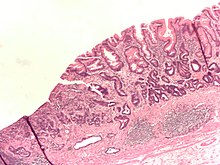Intestinal metaplasia
| Intestinal metaplasia | |
|---|---|
 | |
| Intestinal metaplasia (top middle of image) of the gastric antrum and adenocarcinoma of the stomach (left/centre of image). H&E stain. |
Intestinal metaplasia is the transformation (metaplasia) of epithelium (usually of the stomach or the esophagus) into a type of epithelium resembling that found in the intestine. In the esophagus, this is called Barrett's esophagus. Chronic inflammation caused by H. pylori infection in the stomach and GERD in the esophagus are seen as the primary instigators of metaplasia and subsequent adenocarcinoma formation. Initially, the transformed epithelium resembles the small intestine lining; in the later stages it resembles the lining of the colon. It is characterized by the appearance of goblet cells and expression of intestinal cell markers such as the transcription factor, CDX2.
Risk factors
People of east Asian ethnicity with gastric intestinal metaplasia are at increased risk of stomach cancer.[1]
References
- ^ Choi, AY; Strate, LL; Fix, MC; Schmidt, RA; Ende, AR; Yeh, MM; Inadomi, JM; Hwang, JH (April 2018). "Association of gastric intestinal metaplasia and East Asian ethnicity with the risk of gastric adenocarcinoma in a U.S. population". Gastrointestinal Endoscopy. 87 (4): 1023–1028. doi:10.1016/j.gie.2017.11.010. PMID 29155082.
